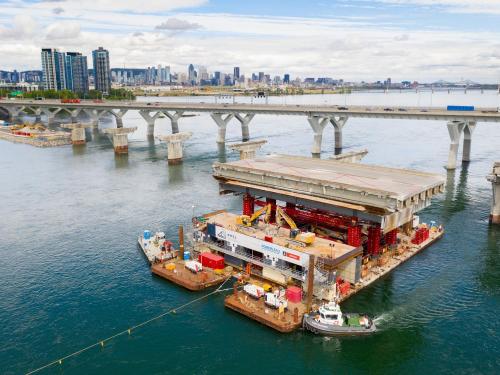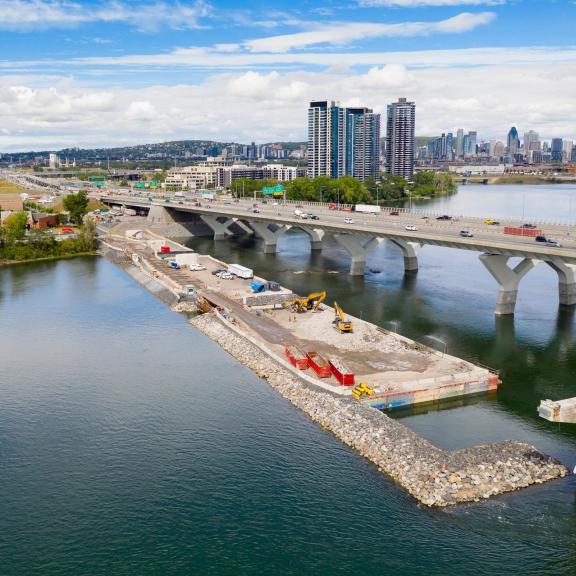Champlain Bridge
Get a closer look at the stories behind the deconstruction.


The Nouvel Horizon St-Laurent (NHSL) consortium, formed by Pomerleau and Delsan-A.I.M. Environmental Services, alongside the Jacques Cartier and Champlain Bridges Incorporated (JCCBI), deconstructed the original Champlain Bridge. The 3.4 km bridge was one of North America’s busiest spans, with 50 million vehicles crossing it each year. We were responsible for maintaining the structural integrity of the bridge during the deconstruction phase to ensure the public’s safety.
Quickly dismantled a section at the outset (for future Metropolitan Express Network work near Nuns' Island).
Adhered to the work periods authorized by Fisheries and Oceans Canada in sensitive aquatic areas.
Coordinated our operations with the St. Lawrence Seaway Management Corporation and Transport Canada.
Tracked the water and ice levels in the river during marine work.
During the deconstruction phase, we dismantled the structure in sections, according to the material (concrete or steel) and the type of access (land or sea), like a dismantling chain. We also adopted an innovative approach, designing a "superstructure" to support the edge beams of the concrete spans that needed to be removed as we removed the wire mesh reinforcement. This large-scale project involved many major challenges—strict requirements and considerable coordination constraints —that required our team to be highly ingenious.
Spanning nearly 3,4 km, the structure stood in a delicate environment where the river, its flora and fauna, and protected species such as the falcon and the white-fronted swallow coexisted. To preserve the St. Lawrence ecosystem, rigorous measures, including environmental monitoring, were implemented throughout the project. Construction also paused during migratory and breeding periods and quiet demolition techniques were used to protect the local bird species.
Waste management, pollution prevention and wildlife protection were at the heart of concerns. Every component of the bridge was carefully assessed for its potential value. Concrete, steel and other materials were recovered and recycled, contributing to the sustainability of the project.
Now that deconstruction is complete, green spaces and parks will be created for the benefit of the community in the now-vacated area. The 7 hectares of recovered land will be transformed into bicycle and walking paths. JCCBI launched a Canada-wide competition to reuse materials from the original Champlain Bridge. More than 176 pieces of steel from the bridge will be used in artistic, architectural, commemorative, community and structural projects.
The sustainable approach adopted by the consortium helped reduce the project's carbon footprint, with constant attention paid to reusing materials, minimizing waste and protecting local biodiversity.
To compensate for the low water level preventing us from approaching the structure with barges, we set up riprap jetties to support the deconstruction equipment.
We closed traffic lanes during the night and weekends and moved entire spans outside the lanes, allowing us to demolish them directly on the ground
| Awards and recognition | Category | Location | Year |
| Association des constructeurs de routes et grands travaux du Québec (ACRGTQ) | Sustainable Development Engineering Award given to Nouvel Horizon St-Laurent and The Jacques Cartier and Champlain Bridges Incorporated (JCCBI). | Montreal, Quebec | 2023 |
264,000
96%
4000